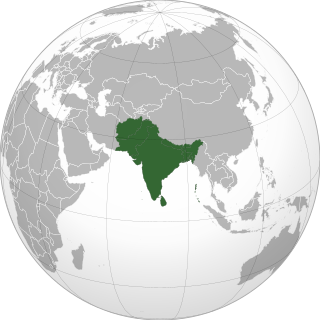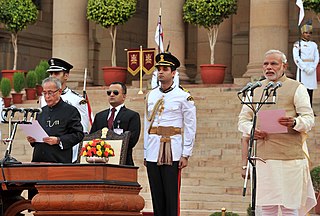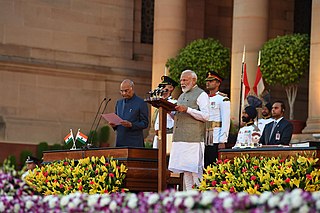
The Maldives has remained an independent nation throughout its recorded history, save for a brief spell of Portuguese occupation in the mid-16th century. From 1900 to 1965, the country was a British protectorate while retaining full internal sovereignty. At its independence in 1965, the Maldives joined the United Nations on 20 September.

The South Asian Association for Regional Cooperation (SAARC) is the regional intergovernmental organization and geopolitical union of states in South Asia. Its member states are Afghanistan, Bangladesh, Bhutan, India, Maldives, Nepal, Pakistan, and Sri Lanka. SAARC comprises 3% of the world's land area, 21% of the world's population and 5.21% of the global economy, as of 2021.

Sushma Swaraj was an Indian lawyer, politician and diplomat who served as the Former Chief Minister of Delhi, and also theMinister of External Affairs of India in the first Narendra Modi government from 2014 to 2019. She was the second person to complete a 5-year term as the Minister of External Affairs, after Jawaharlal Nehru. A senior leader of the Bharatiya Janata Party (BJP), Swaraj was the second woman to hold the office of Minister of External Affairs, after Indira Gandhi. She was elected seven times as a Member of Parliament and three times as a Member of the Legislative Assembly. At the age of 25 in 1977, she became the youngest cabinet minister of the Indian state of Haryana. She also served as Chief Minister of Delhi for a short duration in 1998 and became the first female Chief Minister of Delhi.

The bilateral relations between the Himalayan Kingdom of Bhutan and the Republic of India have been traditionally close and both countries share a "special relationship", making Bhutan a protected state, but not a protectorate, of India. India remains influential over Bhutan's foreign policy, defence and commerce. Bhutan is the largest beneficiary of India's foreign aid.

The Act East policy is an effort by the Government of India to cultivate extensive economic and strategic relations with the nations of Southeast Asia to bolster its standing as a regional power and a counterweight to the strategic influence of the People's Republic of China.

India and Maldives are neighbours sharing a maritime border. India continues to contribute to maintaining security as well as providing financial aid on the island nation.

Secretary-General of the South Asian Association for Regional Cooperation is head of a SAARC Secretariat, which is headquartered in Kathmandu, Nepal. SAARC is an economic and geopolitical union between the eight South Asian member nations, Afghanistan, Bangladesh, Bhutan, India, Maldives, Nepal, Pakistan and Sri Lanka. Secretary-General is appointed for a three-year term by election by a council of Ministers from member states. Secretary-General is assisted by eight deputies, one from each nation, who also reside in Kathmandu. SAARC Secretariat was established in Kathmandu on 16 January 1987 by Bangladeshi diplomat Abul Ahsan, who was its first Secretary-General, and was inaugurated by King Birendra Bir Bikram Shah of Nepal. Since its creation, its member nations have contributed to a total of fourteenth General Secretaries. Golam Sarwar from Bangladesh is the current Secretary-General of SAARC, having assumed charge on 4 March 2023.

Narendra Modi, parliamentary leader of the Bharatiya Janata Party, started the first tenure of his prime ministership, after his oath of office as the 14th Prime Minister of India on 26 May 2014. 45 other ministers were also sworn in along with Modi. The ceremony was noted by media for being the first ever oath of office of an Indian Prime Minister to have been attended by the heads of all SAARC countries.

The foreign policy of the Modi government, also referred to as the Modi doctrine is associated with the policy initiatives made towards other states by the current government of India after Narendra Modi assumed the office of prime minister on May 26, 2014.

Sushma Swaraj was the Indian External Affairs Minister under Prime Minister Narendra Modi from May 2014 till May 2019, responsible for implementing the foreign policy of Narendra Modi. She is only the second women to hold this position after Indira Gandhi.

The most significant initiative made by the Narendra Modi government is the focus on neighbouring countries and major Asian powers coupled with emphasizing on the two decades old Look East policy. Asia being the major focus area of his foreign policy, Modi and his foreign minister chose several Asian countries for their initial bilateral visits. He has made state visits to Bhutan and Nepal and Japan within the first 100 days of his government and also hosted Asian leaders like former Prime Minister Tony Abbott of Australia, President Xi Jinping of China and Prime Minister Nguyễn Tấn Dũng of Vietnam, apart from inviting SAARC leaders in his inauguration ceremony. External Affairs Minister Sushma Swaraj has also made official visits to several Asian capitals like Dhaka, Bangladesh, Kathmandu, Nepal, Naypidaw, Myanmar, Singapore, Hanoi, Vietnam, Manama, Bahrain, Kabul, Afghanistan, Dushanbe, Tajikistan, Malé, Maldives, Abu Dhabi, United Arab Emirates, Seoul, South Korea and Beijing China.
The eighteenth summit of 'South Asian Association of Regional Cooperation' (SAARC) was held in Kathmandu, the capital of Federal Democratic Republic of Nepal during 26–27 November 2014. The theme of the summit was Deeper Integration for Peace and Prosperity, focused on enhancing connectivity between the member states for easier transit-transport across the region. Sushil Koirala, the then Nepalese prime minister, was the main host of the event which took place in Rastriya Sabha Griha The summit took place after an interval of three years as the previous summit was held in 2011 in Maldives.
The Middle East region plays a vital role in India's economy as it supplies nearly two-thirds of India's total oil import, bilateral trade is also flourishing in recent years particularly with UAE and other Arab states of the Persian Gulf. Over the years, millions of Indians mostly working class have migrated to the Persian Gulf region looking for jobs and they account for a sizeable share in the total remittances received from abroad. Indian External Affairs Ministry refers the region as West Asia and not as Middle East which is a more popular attribution, particularly in the Western countries.

The South Asia Satellite, formerly known as SAARC Satellite, is a geostationary communications and meteorology satellite operated by the Indian Space Research Organisation for the South Asian Association for Regional Cooperation (SAARC) region. The satellite was launched on 5 May 2017. During the 18th SAARC summit held in Nepal in 2014, Indian Prime Minister Narendra Modi mooted the idea of a satellite serving the needs of SAARC member nations as a part of his neighbourhood first policy. Afghanistan, Bangladesh, Bhutan, Maldives, Nepal and Sri Lanka are the users of the multi-dimensional facilities provided by the satellite.
Indian foreign aid is the aid given by the Indian government to other governments. India's major quantum of foreign aid is given to neighbouring countries. According to India's budget in 2021–22, its direct overseas aid stood at ₹18,154 crore (US$2.1 billion). That apart, India also extended a direct line of credit worth $30.66 billion to several foreign countries for developmental projects. India has set up 'Indian Agency for Partnership in Development' as a part of Ministry of External Affairs (India) to channelize aid to recipient nations.

Narendra Modi, parliamentary leader of the Bharatiya Janata Party, started his tenure after his oath of office as the 16th Prime Minister of India on 30 May 2019. Several other ministers were also sworn in along with Modi. The ceremony was noted by media for being the first ever oath of office of an Indian Prime Minister to have been attended by the heads of all BIMSTEC countries.

Countries and territories in South Asia have been affected by the COVID-19 pandemic. The first South Asian country to report a confirmed case was Nepal, which documented its first case on 23 January 2020, in a man who had returned from Wuhan on 9 January. As of 2 July, at least one case of COVID-19 has been reported in every country in South Asia. Afghanistan, Bangladesh, Pakistan and Maldives have implemented lockdowns, Sri Lanka has responded with quarantine curfews while India and Nepal have declared a country-wide lockdown. Countries have also instituted various levels of restrictions on international travel, some countries have completely sealed off their land borders and grounded most international flights.
















